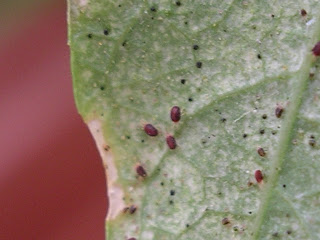It seems that the cooler weather and moisture have disappeared and we've moved into sweltering temperatures. While it will be nice to dry out a bit, expect pest populations to be on the rise. One to watch for is aphids as their populations can increase rapidly.
 Aphids are small, soft-bodied insects with "tailpipes" (better known as cornicles) coming off the tip of the abdomen. Aphids come in a variety of colors and may or may not have wings. They have an incomplete life cycle (egg- nymph- adult) with the nymphs looking similar to the adults but smaller.
Aphids are small, soft-bodied insects with "tailpipes" (better known as cornicles) coming off the tip of the abdomen. Aphids come in a variety of colors and may or may not have wings. They have an incomplete life cycle (egg- nymph- adult) with the nymphs looking similar to the adults but smaller.
These insects have piercing-sucking mouthparts and will insert them into the plant to suck up plant juices. Aphid damage can lead to yellowing, curling and/ or stunting of the plant. Aphids are often found on the underside of leaves or along the stem of the plant. Sometimes they can be found on the plant roots.
Aphids are also honeydew producers. Honeydew is a sticky, sweet substance that may look shiny on the foliage of the plant. Honeydew can also lead to a secondary plant problem called sooty mold. Sooty mold is a fungus that grows on honeydew areas and if you see it on your plants, then you need to look for and manage the honeydew producing insect.
If you discover aphids, you can try a jet of high pressure water to dislodge them from the plant. If that doesn't help, then you can try less toxic pesticides such as insecticidal soap, horticultural oil, pyrethrins or azadirachtin. They can also be killed with synthetic formulations. Please be sure to read the label of the product you choose to apply properly.
Friday, June 10, 2016
Aphids
Friday, August 7, 2015
Spider mites
Do you have webbing covering plants in your landscape? Or maybe, you have webbing covering some of the leaves on your plants? Check the underside of the leaves for spider mites.
Spiders mites are not insects,
Spider mites thrive and reproduce rapidly in hot weather, so conditions have been great for them lately. A generation can be completed within a week when conditions are favorable. Plants under water stress can become infested with spider mites.
Spider mites cause leaves to get a speckled appearance, called stippling, wher
So, what to do about spider mites?
- First off, check that you have an active infestation. Many times people see spider mite damage, but the mites are long gone.
- Ask yourself if you need to do anything or are beneficials doing the job for you.
- Avoid spider mites by reducing stress to your plants with planting in the proper location, watering and fertilizing properly.
- Try knocking spider mites off the plant using high pressure water spray.
- Be aware that sometimes pesticides may cause spider mites to become more of a problem after they are used.
- If you choose to use a pesticide, treat the underside of the leaves where spider mites like to hang out.
Monday, March 23, 2009
Invasive Landscape Pests Seminar
April 16, 2009 1-3 p.m.
Texas AgriLife Research and Extension Center at Dallas
17360 Coit Road Dallas, TX 75252
It started in the 1950s with fire ants and the invasion continues today. Newly imported and exotic insect pests threaten to disrupt Texas horticulture, upset natural ecosystems and cause added expense and heartache for home owners.
Master Volunteers and landscape maintenance professionals have an important role to play as critical “first detectors” of these new pests. This two hour seminar will address new or potential exotic pests likely to be found in our region. We will learn about the new chilli thrips, pink hibiscus mealybug, azalea bark scale, emerald ash borer, Formosan termite and Caribbean crazy
ants. Hands-on sessions will focus on identification and management. You will also learn steps to take if you suspect you have found a new pest. Be the first in your community to be ready for these new invaders.
Training will be held in the Pavilion building at the Texas AgriLife Research and Extension Center at Dallas on April 16th from 1:00-3:00. The meeting is free and open to all Master
Volunteers, garden club members, rosarians, landscape professionals or any citizens with a green thumb. Trainers will include Extension entomologists Allen Knutson, Scott Ludwig, Mike Merchant, and Kim Schofield.
If you would like to attend, please let us know by April 15th.
To register, or for more information, contact the Dallas AgriLife Center at 972-231-5362 or email m-merchant@tamu.edu





